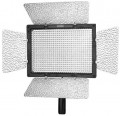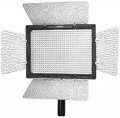—
Autofocus illuminator. The flash has an auxiliary illumination function for the camera's autofocus system. Modern cameras overwhelmingly use the so-called passive autofocus systems that have one serious drawback: very low efficiency in low light and/or low contrast of the object being shot. The autofocus illuminator is designed to solve this problem: before focus, the scene is illuminated by a separate lamp, placed, in this case, directly in the flash body. This provides enough light for normal autofocus operation. Most often, backlight lamps give light with a characteristic reddish tint, however, in some advanced models, infrared illumination is used — invisible to the eye, but perceived by the camera. In addition, illumination systems can use a special light pattern instead of a solid beam, which further simplifies the task of autofocus systems. Anyway, the presence of this function is especially relevant given the fact that the flash is often used as a light source in low light.
— Control on the camera. The ability to change the settings for the flash using the controls of the camera itself, to which it is connected. In some cases (for example, with a wireless connection), this is much more convenient than switching attention from the camera to the flash.
—
Automatic zoom. The ability to automatically change the angle of dispersion of the flash light. For the angle of dispersion,
...see the relevant paragraph above, but here we note that this function provides synchronization between the flash and the lens: when the focal length of the lens changes, the angle of dispersion automatically changes. This provides the most effective illumination of the scene and at the same time relieves you of the need to manually re-adjust the flash to a changed angle of view each time.
— Manual zoom. Possibility to change the flash spread angle (see "Light spread angle") manually. This function expands the possibilities for "fine" tuning of work parameters and allows you to set parameters that are not available with automatic zoom (see above). In addition, it will be useful if you have to use several prime lenses with different focal lengths — the flash can be easily adjusted to each of them.
— Wireless control. Ability to wirelessly connect the flash to the camera or to another flash as master/slave (if available, see below). The format and specific features of such a connection may be different: wired connection, IR channel, radio, etc. Wireless control is indispensable if the flash must be placed away from the camera; it also makes it easier to create multiple flash systems for optimum lighting. These features are especially useful for studio shooting (although it's not limited to this).
— Work in master mode. The ability to operate the flash as a master flash for a system of multiple flashes. The entire system is controlled through the master flash, the operation parameters of the slave flashes are set, and the command to fire is given (note that the master flash itself may not fire at all). If you plan to shoot using a multi-flash system, you will definitely need a model with this function — without it, creating a system is impossible. Of course, master and slave flashes must be mutually compatible; this point should be clarified separately.
— Work in slave mode. The ability to work as a flash as a slave in a system of several flashes. In this mode, the device is connected to the master flash and fires on command from it. For more information on flash systems, see "Master Operation" above.
— Diffuser. The colour of the diffuser supplied with the on-camera light source (see "Type"). Colour can be: orange, white, pink or yellow.
A diffuser is a special filter designed to scatter light from individual LEDs, and also, in some cases, to give it a certain colour and change the colour temperature.
— Radio synchronizer. A device designed to wirelessly control a flash or a set of flashes (if each has its own receiver). Usually a separate module installed in the hot shoe; on command to fire, this module sends a radio signal to all receivers tuned to it, ensuring synchronous flash firing. At the same time, some models of luminaires with such a function are capable of receiving via the radio channel not only the start signal, but also the operating parameters (primarily the duration and power of the pulse).The ability to power the device from a 230 V network, in other words, a regular household outlet.
This option is used solely as an addition to an autonomous power source — batteries or an accumulator; purely "network" devices are not available today. It expands the connectivity options and can significantly increase the battery life of the flash: if there is an outlet nearby, the device can be powered from it, thus saving battery power. In addition, this connection can also be used to charge the built-in battery, including right at work.
Note that the described advantages are relevant mainly for powerful light sources with high power consumption. At the same time, flashes with a traditional flash format consume relatively little energy, and it is quite possible to get by with replaceable batteries. Therefore, the vast majority of
mains powered models are on-camera light sources (see "Type"). In this regard, it is also worth noting that many of these lamps, especially large and powerful ones, can also be used on a tripod as stationary sources of illumination; in such cases, plug-in power is often the perfect option.

